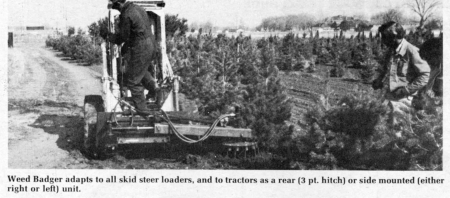
Slickest machine we've seen for keeping trees of any age virtually free of weeds -- right up to the trunk of each tree -- is the Weed Badger, introduced by the Town and Country Environmental Development Co., Marion, N. Dak.
The "business end" of the machine is a hydraulically driven rotor that turns at 110 rpm's. The standard Weed Badger rotor attachment is 16 in. in dia. and has 11 vertical-wound spring teeth bolted to it.
Initially designed for use with all makes of skid-steer loaders, the machine is now available for side or rear (3-pt. hitch) mount on farm tractors. (You don't have to remove the front-end loader to use the Weed Badger.)
"It'll work in areas no other high production machine will reach," says Jack Anderson, inventor-manufacturer. Probably the most surprising feature is that, regardless of how heavy the stand of weeds, or the type of weeds, the rotor won't wrap or plug. What's more, it'll work in mud, rocks, heavy sod and most other extreme soil conditions."
To weed a row of trees, you drive alongside the row, with the outer edge of the rotor running just over the center line of the tree row. Using a skid-steer loader, the driver steers the rotor around and within an inch or less of the trees.
On tractor mounted models, a hydraulically-operated sensor arm automatically retracts the rotor to clear each tree. In cultivating newly seeded saplings not yet large enough to work against the sensor arm without bending over, the operator controls the in and out movement of the arm with a manual control. When the valve is released, Automatic Function is restored.
"Action of the rotating tines provides near-perfect weed control in the rotor's path," explains Anderson. "We figure one pass with the Weed Badger is equivalent to 20 cultivations by ordinary means."
Anderson notes that the rotor stirs the soil vigorously, reducing it to a fine texture, which reduces loss of moisture to the atmosphere. "This stirring action also incorporates air into the soil which, in turn, stimulates soil bacteria and releases nitrogen. In actual side by side tests, we've seen as much as a 30-in. difference in the growth of trees cultivated with the Weed Badger, and those cultivated between but not in the row."
Anderson adds that the Weed Badger can be used to prepare sod or other soil in strips for planting trees. It can also be used to cultivate under fence lines, in fence corners, and right up tight to farm buildings. The Weed Badger is also being used to stir litter in poultry barns, keeping it fresh longer.
Here are other key features:
--Retraction speed of the arm in maneuvering around trees is directly proportional to travel speed to insure automatic "close up" cultivation, regardless of how fast the machine is traveling down the row.
--The machine can be operated on the right or left side of the tractor or skid steer loader, depending on which side the operator prefers. Average down-the-row working speed is 1 1/2 to 2 mph.
--Regardless of terrain, the rotor stays in the ground and digs at a uniform depth, and with a constant digging pressure. For example, if the unit is mounted on the left side of the tractor and, in going down the row, the right wheels of the tractor dip into a depression, a hydraulic circuit valve automatically takes over to hold the arm in the ground and keep it at its pre-set digging depth.
For working in tight quarters, a smaller diameter (12-in.) rotor called the Weed Gopher is available. The Weed Buster rotor, equipped with heavy spike teeth, is available for use in digging up old sod or other heavy vegetation.
The hydraulic motor used on the machine's rotor can be used to power grain augers, or used with an auger to serve as a post hole digger.
